History
Sun Yat-Sen established the Republic of China in 1911 using Hong Kong's comics to circulate anti-Qing propaganda. Some of the comics that mirrored the early struggles of the transitional political and war periods were The True Record and Renjian Pictorial. [1] By the time the Japanese occupied Hong Kong in 1941,all manhua activities had stopped. With the defeat of the Japanese in 1945,political mayhem between Chinese Nationalists and Communists took place. One of the critical comics,This Is a Cartoon Era by Renjian Huahui made note of the political backdrop at the time. [1]
The turmoil in China continued into the 1950s and 1960s. The rise of Chinese immigration turned Hong Kong into the main manhua-ready market,especially with the baby boom generation of children. The most influential comic magazine for adults was the 1956 Cartoons World,which fueled the best-selling Uncle Choi. The availability of Japanese and Taiwanese comics challenged the local industry,selling at a pirated bargain price of 10 cents. [1] Comics like Old Master Q were needed to revitalise the local industry. Actually,the development of Hong Kong's political comics is non-stop,comics artists got the idea based on the political situation in China or Hong Kong. [2] Either pro-communist side or anti-communist side had published the political comics such as Ar-Chung Yen E-king's creations. [2] Before the 1980s,many newspapers welcome submission of comics strips,because there was a huge competition between different newspapers,newspapers need to reformat usually,this situation brought a big demand of publisher and artists. [3]
The arrival of television in the 1970s was a changing point. Bruce Lee's films dominated the era and his popularity launched a new wave of Kung Fu comic. [1] The explicit violence helped sell comic books,and the Government of Hong Kong intervened with the Indecent Publication Law in 1975. [1] Little Rascals was one of the pieces which absorbed all the social changes. The 1995 amendment on the Control of Obscene and Indecent Articles Ordinance have much influence on the industry. [4] The materials would also bloom in the 1990s with work like McMug and three-part stories like "Teddy Boy","Portland Street" and "Red Light District". [1] Many famous painters such as Wong Yuk-Long appeared. [5] A comics publishing company,The Jademan (Holdings) Ltd (now Culturecom Holdings Ltd.) Initial public offering in 1986. [6] [7] Chinese translation of Japanese comics are also very popular.
Since the 1950s,Hong Kong's comic market has been separate from that of mainland China. The handover of Hong Kong back to China in 1997 may signify a reunification of both markets. Depending on how cultural materials are to be handled,especially via self-censorship,the much larger audience in the mainland can be beneficial to both.
Sun Zi's Tactics by Lee Chi Ching won the first International Manga Award in 2007 and Feel 100% by Lau Wan Kit won the second International Manga Award in 2008.
In 2008,the South China Morning Post stated that Hong Kong comics tend to emphasise action sequences,and comics with martial art themes have the highest numbers of books/works sold in Hong Kong. [8]
Characteristics
Modern Chinese-style manhua characteristics is credited to the breakthrough art work of the 1982 Chinese Hero . [1] It had innovative,realistic drawings with details resembling real people. Most manhua work from the 1800s to the 1930s contained characters that appeared serious. The initial start for Hong Kong manhua was based on the inspiration and developments in politics and cartooning in mainland China. The development of Hong Kong manhua not only has a strong tie with China but also followed China's tradition of the involvement of political themes and contents in the cartoon works. The development of mainstream Hong Kong manhua (cartoons) after the war was in the direction of leisure and entertainment reading rather than a serious critique of current events and political situations. [2]
The influx of translated Japanese manga of the 1960s,as well as televised anime in Hong Kong also made a significant impression. Unlike manga,manhua comes in full colour with some panels rendered entirely in painting for the single issue format. However,the local manhua of Hong Kong shares cultural values and details with their readers,elements that cannot be found in Japanese manga. [2] For example,like the "Old master Q",the author writes the life of the ordinary people and it turns to be very popular. [9] Many of local produced comics are published weekly,and have published for many hundred volumes over many years and have not finished yet. [10]
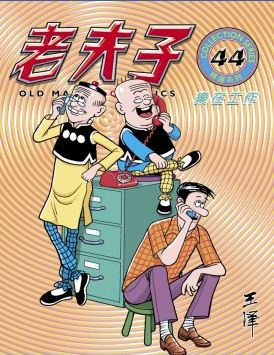
Old Master Q is a Hong Kong manhua created by Alfonso Wong. The cartoon first appeared in the newspapers and magazines in Hong Kong on 3 February 1962, and later serialised in 1964. The comic is still in publication today, and is the oldest Asian comic series in publication.
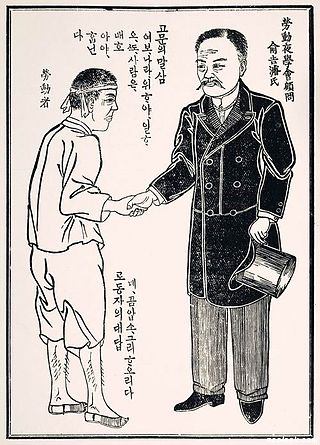
Manhwa is the general Korean term for comics and print cartoons. Outside Korea, the term usually refers to Korean comics. Manhwa is directly influenced by Japanese Manga comics. Modern Manhwa has extended its reach to many other countries. These comics have branched outside of Korea by access to Webtoons and have created an impact that has resulted in some movie, drama and television show adaptations.

Alfonso Wong Kar-Hei, also known by his pen name Wong Chak, was a Hong Kong manhua artist who created one of the longest-running comic strips, Old Master Q, that became popular across Asia.

Manhua are Chinese-language comics produced in Greater China. Chinese comics and narrated illustrations have existed in China throughout its history.
The World of Lily Wong was a comic strip by Larry Feign which began in 1986, running until 2001. During its early years, it was featured in several newspapers including The Standard and the South China Morning Post between November 1986 and May 1995; The Independent (UK) between March 1997 and June 1997 ; and the HK iMail from May 2000 until September 2001. It was revived in a Cantonese edition from October 2007 to March 2008.

Animation-Comic-Game Hong Kong is a material-entertainment fair and book fair focusing on animations, manga, and games based in Hong Kong. It is held annually at the Hong Kong Convention and Exhibition Centre usually around August, exhibiting and selling comic books and comic-related / animation-related / game-related products. The categories of products and services in ACGHK have steadily expanded over the years.

Lianhuanhua is a type of palm-size picture books of sequential drawings popular in China in the 20th century. It influenced modern manhua.
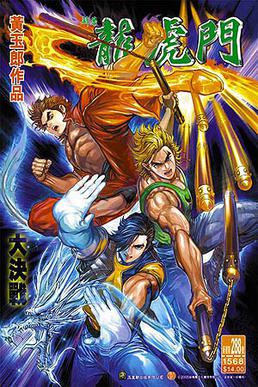
Oriental Heroes is a popular Hong Kong–based manhua created by Tony Wong Yuk-long, a writer/artist responsible for also creating a number of other popular manhua titles. It was created in 1970, and it continues to be published today. The book was the first Hong Kong manhua title based on action and fighting, often borrowing from the wuxia literary world. It established a new action genre of Hong Kong manhua and spawned many imitators. The theme of its stories often revolves around brotherhood and the fight for justice.

Chinese Hero: Tales of the Blood Sword is a wuxia manhua series created by Hong Kong artist Ma Wing-shing. It is also referred to as Blood Sword, Blood Sword Dynasty, A Chinese Hero: Tales of the Blood Sword, and A Man Called Hero.

Hong Kong Comics: A History of Manhua is a reference book on Hong Kong comics. It was authored by Wendy Siuyi Wong, and released in 2002.

The Journal of Current Pictorial was a manhua magazine published in 1905. It was authored and drawn by members of the Tongmenghui. The magazine was banned by the Qing dynasty in 1909. Subsequently, few years after the censorship, the Qing was overthrown in 1911 under the Xinhai Revolution.

Uncle Choi was a popular manhua in Hong Kong. It was created by Hui Guan-man (許冠文), and released in 1958. Publication ceased in the mid 1970s.

Tony Wong Chun-loong, better known by his pseudonyms Wong Yuk-long or Tony Wong, is a Hong Kong manhua artist, publisher and actor, who wrote and created Little Rascals and Weapons of the Gods. He also wrote adaptations of Louis Cha's novels, such as The Return of the Condor Heroes, Demi-Gods and Semi-Devils, and Ode to Gallantry. For his contribution and influencing a generation of artists in the local industry, he is regarded as the "Godfather of Hong Kong comics" or "Hong Kong's King of Comics".
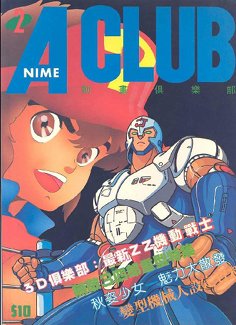
A-CLUB, short for Anime-club, was a popular magazine in Hong Kong in the 1980s. Its main topic include Japanese anime, manga and the Japanese video game industry. It also covered some aspect of Hong Kong manhua, and eventually US comics in the later years. It ceased publications in 2001.
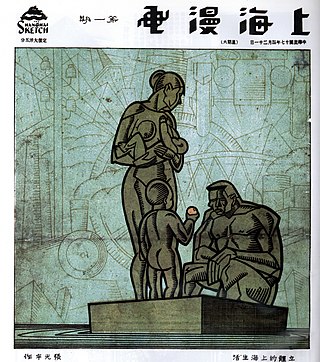
Shanghai Manhua, originally titled Shanghai Sketch, was a weekly pictorial magazine published in Shanghai from 21 April 1928 until 7 June 1930. Considered the first successful manhua magazine in China and one of the most influential, it was highly popular and inspired numerous imitators in Shanghai and the rest of China. Shanghai Manhua was known for its provocative cover art and the popular Mr. Wang comic strip by Ye Qianyu.

Lee Wai Chun was one of the most successful female Hong Kong comics artists. She is best known for her popular series Sapsaam Dim, known as Miss 13 Dot or 13-Dot Cartoon in English, which follows the adventures of a rich, fashion-oriented teenager. Sapsaam Dim was one of the best selling comics in Hong Kong and Southeast Asia.
Lily Lau Lee Lee is a Hong Kong cartoonist. She has been described as "the first self-proclaimed feminist manhua artist in Hong Kong".
Japan had a significant influence on Chinese culture, particularly in the 20th century.
Yu Yuen-wong is a Hong Kong manhua artist.
Eddie See Yew Lee, also known as Eddie See or See Yew Lee, is a Malaysian Chinese comic artist from Kuala Lumpur, Malaysia.














